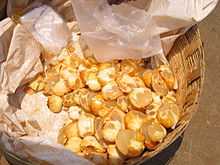Borassus
| Borassus | |
|---|---|
 | |
| Borassus flabellifer in Angkor Wat, Cambodia | |
| Scientific classification | |
| Kingdom: | Plantae |
| (unranked): | Angiosperms |
| (unranked): | Monocots |
| (unranked): | Commelinids |
| Order: | Arecales |
| Family: | Arecaceae |
| Subfamily: | Coryphoideae |
| Tribe: | Borasseae |
| Subtribe: | Lataniinae |
| Genus: | Borassus L.[1] |
| Species | |
|
See text. | |
Borassus (Palmyra Palm) is a genus of six species of fan palms, native to tropical regions of Africa, Asia and New Guinea. They are tall palms, capable of growing up to 30 m high (98 ft). The leaves are long, fan-shaped, 2 to 3 m in length. The flowers are small, in densely clustered spikes, followed by large, brown, roundish fruits.
Species
- Borassus aethiopum - African Palmyra Palm (and other names) (tropical Africa)
- Borassus akeassii - Ake Assi's Palmyra Palm (West Africa)
- Borassus flabellifer - Asian Palmyra palm/Lontar palm/Doub palm/Sea Coconut (southern Asia and southeast Asia)
- Borassus heineanus - New Guinea Palmyra Palm (New Guinea)
- Borassus madagascariensis - Madagascar Palmyra Palm (Madagascar)
- Borassus sambiranensis - Sambirano Palmyra Palm (Madagascar)
Cultivation and uses


Palmyra palms are economically useful, and widely cultivated in tropical regions. The palmyra palm has long been one of the most important trees of Cambodia and India, where it has over 800 uses. The leaves are used for thatching, mats, baskets, fans, hats, umbrellas, and as writing material.
In Cambodia, the tree is a national flora symbol/emblem that is seen growing around Angkor Wat. The sugar palm can live over 100 years.
In ancient Indonesia and ancient India, the leaves were used as paper to write on, as a kind of papyrus. In India, leaves of suitable size, shape and texture, and sufficient maturity are chosen. They are then preserved by boiling in salt water with turmeric powder. The leaves are then dried; when they are dry enough, the faces of the leaves are polished with pumice stone. Then they are cut in the proper size. A hole is cut out in one corner. Each leaf will have four pages. The writing is done with a stylus. The writing is of a very cursive and interconnected style. The leaves are then tied up as sheaves.
The stalks are used to make fences and to make a strong, wiry fiber suitable for cordage and brushes. The black timber is hard, heavy, and durable and is highly valued for construction, such as for wharf pilings.


The tree also yields many types of food. The young plants are cooked as a vegetable or roasted and pounded to make meal. The fruits are eaten roasted or raw, and the young, jellylike seeds are also eaten. A sugary sap, called toddy, can be obtained from the young inflorescence, either male or female ones. toddy is (called "kallu (కల్లు)" in Telugu. The toddy is fermented to make a beverage called arrack, or it is concentrated to a crude sugar called jaggery/palm sugar. It is called Gula Jawa (Javanese sugar) in Indonesia and is widely used in the Javanese cuisine. The roots can be dried to form Odiyal, a hard chewable snack. In addition, the tree sap is taken as a laxative, and medicinal values have been ascribed to other parts of the plant.
In Tamil culture
The Palmyra tree is the official tree of Tamil Nadu. In Tamil culture it is called karpaha,"Nungu" "celestial tree", and is highly respected because all its parts can be used. The recently germinated seeds form fleshy sprouts below the surface which can be boiled and eaten as a fibrous, nutritious food. The germinated seed's hard shell is also cut open to take out the crunchy kernel which tastes like a water chestnut but is sweeter. The ripe fibrous outer layer of the fruits is edible after boiling or roasting. When the fruit is tender, the kernel inside the hard shell is an edible jelly that is refreshing and rich in minerals. When the crown of the tree from which the leaves sprout is cut we get an edible cake. In ancient times, dried palm leaves were used to write manuscripts.
References
- ↑ Linnaeus, Species Plantarum 1187. 1753. Type:B. flabellifer
External links
| Wikimedia Commons has media related to Borassus. |
- http://www.plantnames.unimelb.edu.au/Sorting/Borassus.html -excellent Australian site of multilingual fruit names
- http://www.pacsoa.org.au/palms/Borassus/index.html
- http://www.borassus-project.net